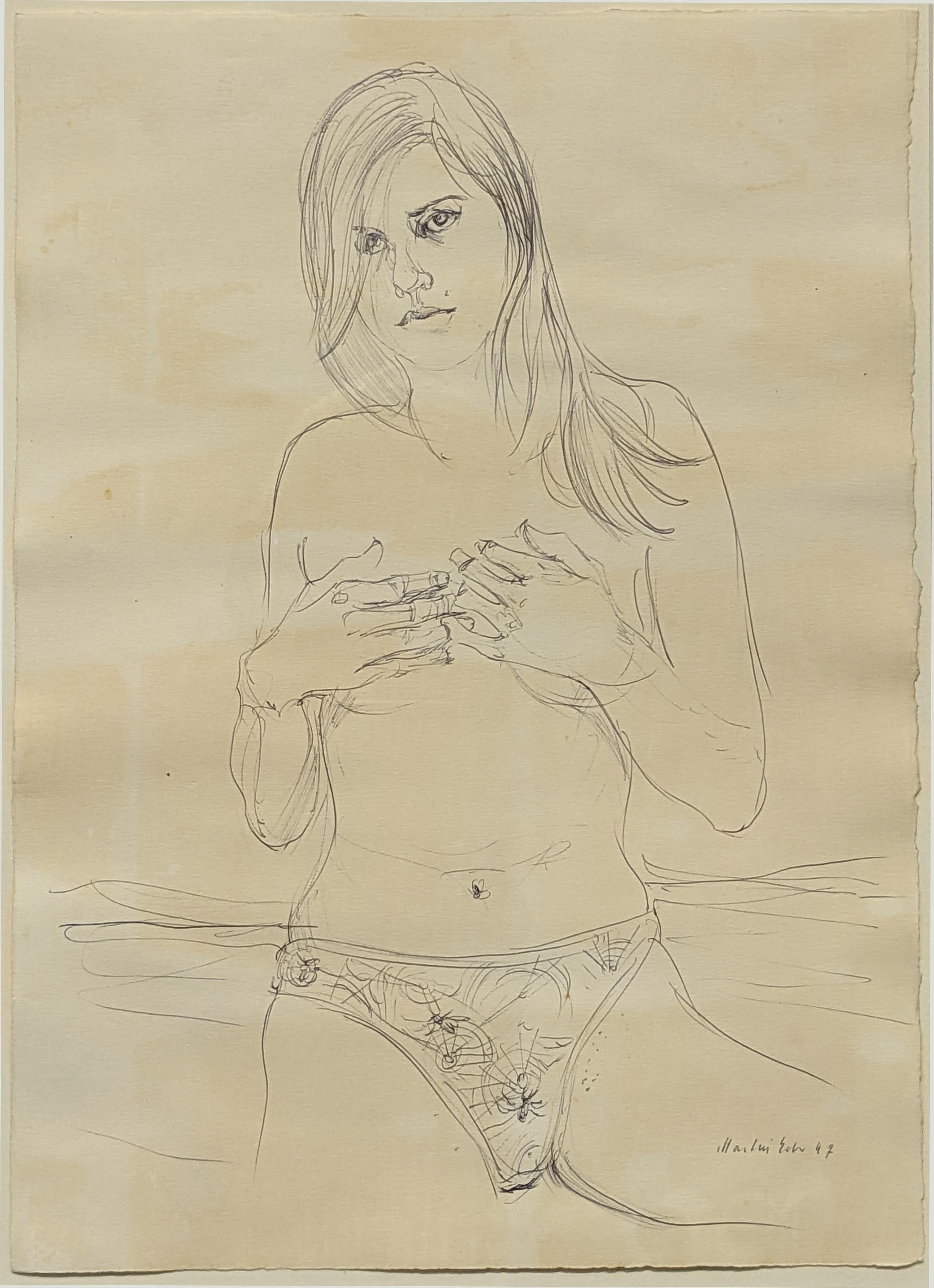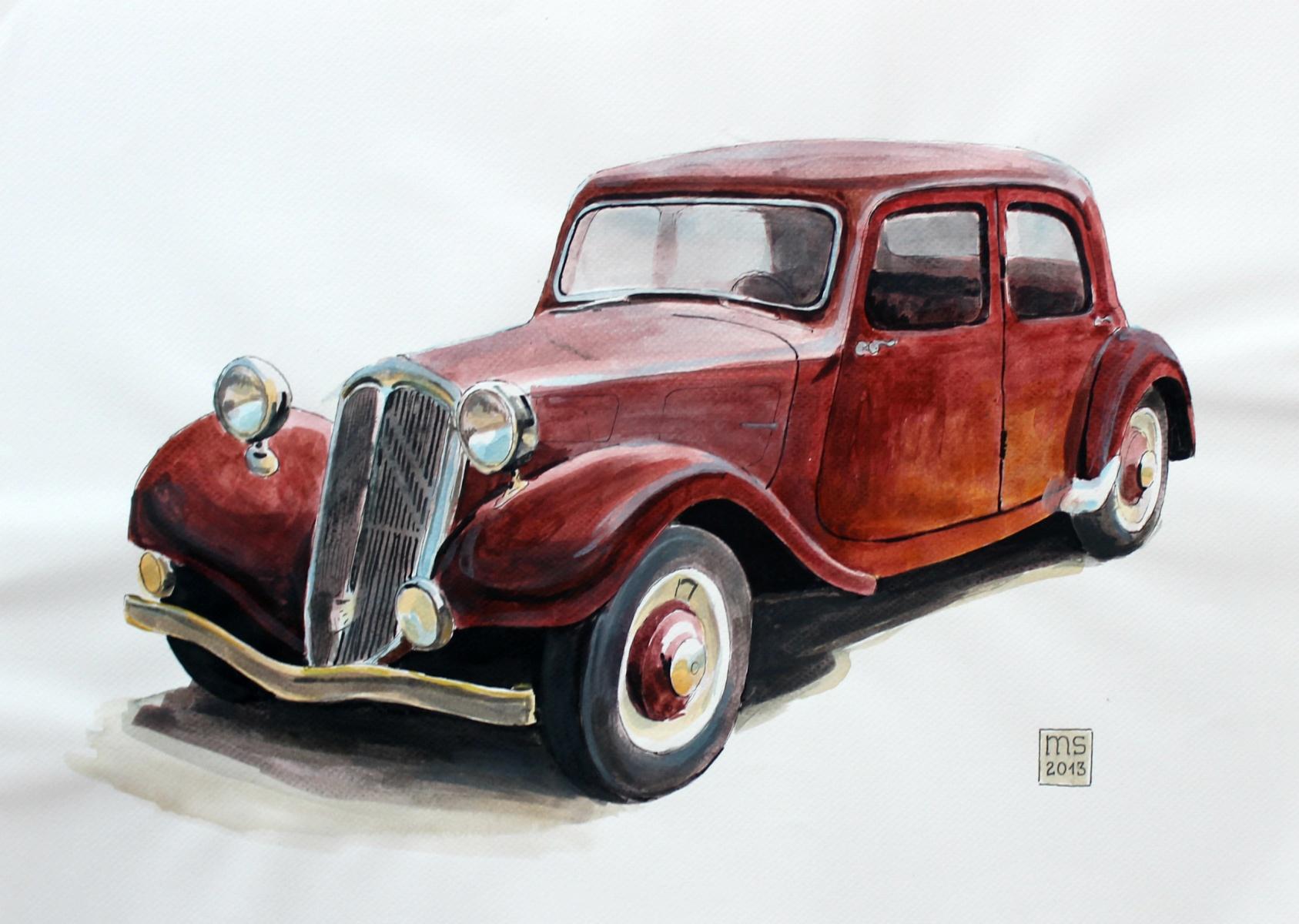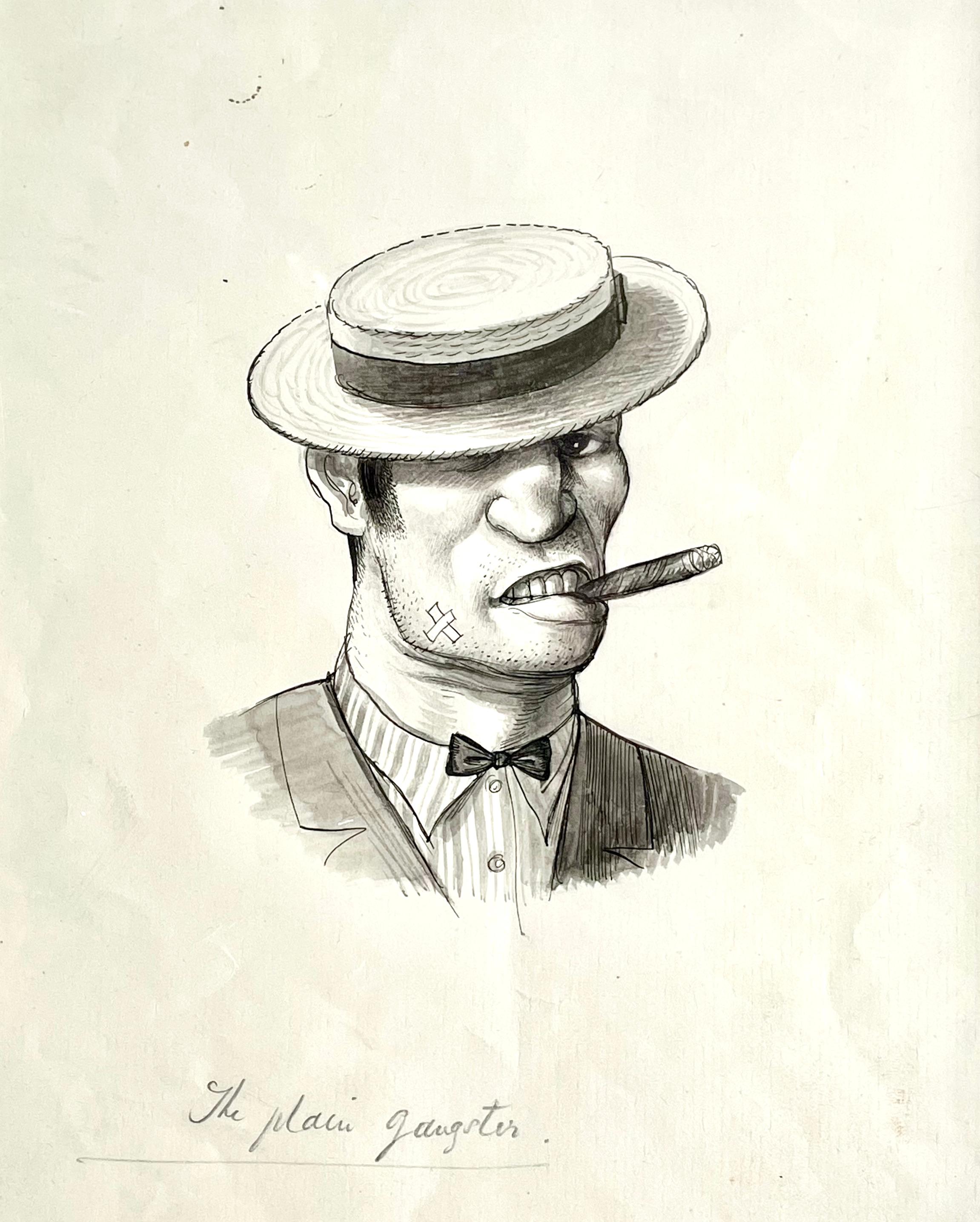Items Similar to London Stock Exchange Waiter - 1960s British drawing by Francis Watt
Want more images or videos?
Request additional images or videos from the seller
1 of 2
Frances WattLondon Stock Exchange Waiter - 1960s British drawing by Francis Watt
About the Item
FRANCES WATT
(1923-2009)
London Stock Exchange Waiter
Pen and ink and watercolour wash, unframed, in mount only
17 by 13 cm., 6 ½ by 5 in.
Edith Frances Watt was born in Falkirk in 1923. In 1926 the family moved to Switzerland when her father, the Rev Thomas Meikle Watt, was appointed permanent chaplain to the Church of Scotland in Geneva. Her father died in 1938 and the family returned to Scotland where Frances continued her schooling at Aberdeen High School for Girls. Her mother moved the family to London in about 1940 and they settled in Southwood Lawn Road, Highgate. Frances attended the Hornsey School of Art were she gained a National Diploma in Design before going on to study at the Byam Shaw School in London, where she later taught. In Highgate she was a member of the Highgate Artists Group, which included Sir Kyffin Williams among its exhibiting members, and she was also an active member of the Highgate Choral Society, designing many programmes and posters for its productions in the 1950s.
In the early 1960s she was commissioned by the Council of the Stock Exchange to record the daily life in the Square Mile. Over the next 20 years she was brilliantly placed to observe the enormous changes taking place in the great institutions of the Stock Exchange and Lloyd’s of London. She exhibited at the Royal Academy, her first exhibit being Stockbrokers Talking, 1961 (no.681). She also exhibited at the Royal Scottish Academy, Royal Institute of Oil Painters, Paris Salon and elsewhere. Apart from her City subjects she painted many landscapes and figure subjects.
Frances Watt never married. She moved back to Scotland in 1992 and died there in 2009.
Her 1963 painting Interior of Lloyd’s is in the collection of the City of London Corporation and a 1952 landscape, Park with a Boating Lake, is in the collection of Bruce Castle Museum, Haringey.
- Creator:Frances Watt (British)
- Dimensions:Height: 6.7 in (17 cm)Width: 5.12 in (13 cm)
- Medium:
- Movement & Style:
- Period:
- Condition:
- Gallery Location:London, GB
- Reference Number:1stDibs: LU1028310081232

About the Seller
4.9
Vetted Seller
These experienced sellers undergo a comprehensive evaluation by our team of in-house experts.
Established in 2004
1stDibs seller since 2018
50 sales on 1stDibs
Typical response time: 15 hours
- ShippingRetrieving quote...Ships From: Banbury, United Kingdom
- Return PolicyA return for this item may be initiated within 14 days of delivery.
More From This SellerView All
- The Plain Gangster - Early 20th Century British Illustration by Rex WhistlerLocated in London, GBREX JOHN WHISTLER (British 1905-1944) The Plain Gangster Inscribed with title Pen, brush and ink Framed 20 by 16.5 cm., 8 by 10 ½ in. (frame size 39 b...Category
Early 20th Century Realist Portrait Drawings and Watercolors
MaterialsInk
- Charles Mahoney - Self Portrait, Modern British watercolour and ink drawingLocated in London, GBCHARLES MAHONEY (1903-1968) Self Portrait – A Study for Muses Signed with initials l.l. Pen and ink with sepia watercolour Framed 27.5 by 18 cm., 10 ¾ by 7 in. (frame size 46 by 3...Category
Mid-20th Century Realist Figurative Drawings and Watercolors
MaterialsInk, Watercolor
- 19th Century British Original Pen and Ink Sporting Illustration by A C CorbouldLocated in London, GBALFRED CHANTREY CORBOULD (1852-1920) “Which Way?” Signed and dated l.r.: ACCORBOULD/FEB 78 Pen and brown ink with china white heightening Un...Category
Late 19th Century Realist Animal Drawings and Watercolors
MaterialsInk
- The Travellers - 1920s British Children's book illustration by Frank WatkinsBy Frank WatkinsLocated in London, GBFRANK WATKINS (1863-1929) The Travellers Signed Pen and ink, unframed, in conservation mount only 17.5 by 26 cm., 7 by 10 ¼ in. (frame size 33.5 by 41 cm., 13 ¼ by 16 in.) Frank Henry Watkins was born in Lambeth, London and was the son of a bank clerk. He worked as a children’s book and comic illustrator in the early 20th century, drawing for many children’s stories including Dolly Twoshoes (1901); The Wonder and Dolly Daydream (1902); Illustrated Chips and Dick and Daisy (1919-1921) and also for Merry Moments. He provided book illustrations for The Man From the Moon by Philip Carmichael (1909); The Sun’s Babies by Edith Howes (1910); The King Who Never Died: Tales of King Arthur by Dorothy Senior (1910) and Fairy Rings...Category
1920s Realist Figurative Drawings and Watercolors
MaterialsInk
- Gentleman of the RoadBy Joshua Charles ArmitageLocated in London, GB“IONICUS” JOSHUA CHARLES ARMITAGE (1913-1998) Gentleman of the Road Pen and ink heightened with white, unframed, in conservation mount only 12 by 8.5 cm., 4 ¾ by 3 ¼ in. (mount si...Category
Mid-20th Century Realist Figurative Drawings and Watercolors
MaterialsInk
- Jack Escapes the Giant - 1920s British Children's illustration by Frank WatkinsBy Frank WatkinsLocated in London, GBFRANK WATKINS (1863-1929) Jack Escapes the Giant Pen and ink, unframed, in conservation mount only 24 by 29 cm., 9 ¾ by 11 ½ in. (mount size 40 by 44.5 cm., 15 ¾ by 17 ½ in.) Frank Henry Watkins was born in Lambeth, London and was the son of a bank clerk. He worked as a children’s book and comic illustrator in the early 20th century, drawing for many children’s stories including Dolly Twoshoes (1901); The Wonder and Dolly Daydream (1902); Illustrated Chips and Dick and Daisy (1919-1921) and also for Merry Moments. He provided book illustrations for The Man From the Moon by Philip Carmichael (1909); The Sun’s Babies by Edith Howes (1910); The King Who Never Died: Tales of King Arthur by Dorothy Senior (1910) and Fairy Rings...Category
1920s Realist Figurative Drawings and Watercolors
MaterialsInk
You May Also Like
- untitled / ohne TitelBy Martin EderLocated in New York, NYMartin Eder untitled work on paper executed in ballpoint pen with traces of watercolor. Ohne Titel Arbeit auf Papier, ausgeführt in Kugelschreiber mit Spuren von Aquarell. 2007Category
Early 2000s Realist Nude Drawings and Watercolors
MaterialsInk, Watercolor, Pen
- Citroen 15CV - Contemporary Watercolor & Ink Painting, Vintage Car, RealisticBy Mariusz SzałajdewiczLocated in Warsaw, PLMariusz Szalajdewicz (b. 1974) Studied at the Faculty of Architecture at Warsaw University of Technology, where he mastered the drawing skill. Architect and urbanist, illustrator.Category
21st Century and Contemporary Realist Figurative Drawings and Watercolors
MaterialsPaper, Ink, Watercolor
- Volvo 164 - XXI Century, Contemporary Watercolor & Ink Painting, Vintage CarBy Mariusz SzałajdewiczLocated in Warsaw, PLMariusz Szalajdewicz (b. 1974) Studied at the Faculty of Architecture at Warsaw University of Technology, where he mastered the drawing skill. Arc...Category
21st Century and Contemporary Realist Figurative Drawings and Watercolors
MaterialsPaper, Ink, Watercolor
- "Boating on the Morin River"By André Dunoyer de SegonzacLocated in Saint Amans des cots, FRPen, ink, watercolor and wash on paper by André Dunoyer de Segonzac, France, 1922-1924. Boating on the Morin River. Measurements : with frame: 52.5x65x2 cm - 20.7x25.6x0.8 inches / without frame: 36.5x45 cm - 14.4x17.7 inches. Signed lower left "A. Dunoyer de Segonzac". Colors may vary slightly depending on your screen. The lighter band at the top and the bottom of the piece, visible in the first picture, is only due to the reflection in the protective glass. It does not exist. In its frame gilt with gold leaf and its protective glass. André Dunoyer de Segonzac was born in Boussy-Saint-Antoine (Essonne) July 7, 1884. After his schooling at high school Henri IV, as early as 1900, he attends classes at the National School of Fine Arts in Paris in free listener where he will befriend Charles Dufresne. In 1903, he enters the private studio of Luc-Olivier Merson. In 1907, he studies with Jean-Paul Laurens and attends the La Palette and Colarossi academies in Montparnasse. He meets Luc-Albert Moreau and Jean-Louis Boussingault with whom he shares a studio. His first drawings are published in 1908 in The Great Review and The Witness. Nearly indifferent to contemporary aesthetic revolutions, Dunoyer de Segonzac undertakes, with Jean-Louis Boussingault and Luc-Albert Moreau, to revive Gustave Courbet's realism by performing still lifes, nudes, landscapes, in a thick paste and masonry . In one of his letters to the painter Maurice Boitel, he wrote in the 1950s: "I have not forgotten the heroic period of the independents - when we were grouped around Paul Signac, the charming and valiant Maximilien Luce - in these barracks where the living and authentic Art was grouped outside the academic formulas - or literary and systematic tendencies - which were to lead to this abstract aesthetic of which the painting dies. " In 1908, he begins exhibiting at the Salon d'Automne and the Salon des Indépendants, with Paul Signac and Maximilien Luce. He befriends Apollinaire, Max Jacob, Raoul Dufy and Vlaminck. From this period, renting a house belonging to Signac, Dunoyer discovers the landscapes of Saint-Tropez, to which he will remain faithful and where he lived until the end of his life. He stays in Saint-Tropez only in the summer season. For the rest, he leads a real nomadic life, in search of the motive especially through the Île-de-France, the Grand Morin valley, Feucherolles, Chennevières-sur-Marne, Guyancourt, etc. "I also worked a lot on the banks of the Seine in Chatou, Bougival, Andrésy, Poissy and Triel that I particularly like, with its beautiful Gothic church that is reflected in the Seine and the high wooded hills that surround him", he will say. In 1910, he knows fashion designer Paul Poiret and meets Max Jacob, Raoul Dufy and Vlaminck. From 1910 to 1914, he travels to Italy, Spain, North Africa, and is interested in sport and dance (drawings of Isadora Duncan's Russian Ballets, 1911, The Boxers1910). From 1914 to 1918, mobilized in the infantry, he makes the war hardly, before being assigned to camouflage. He performs many war drawings, valuable for their artistic and documentary value. From 1919, he appears again in many exhibitions, including major Parisian salons. Nearly indifferent to contemporary aesthetic revolutions, Dunoyer de Segonzac undertakes, with Boussingault and Moreau, to revive Courbet's realism by performing still lifes, nudes, landscapes, in a thick and masonry paste. Enlisted in engraving by Jean Émile Laboureur, he makes nearly 1,600 brass plaques from 1919 to 1970. He was president of the Society of French painters-engravers. In 1921, he meets Paul Valéry, Léon-Paul Fargue and Jean Cocteau. In 1928, he makes a trip to America where he met with great success. In 1930, he becomes friend with Derain. In 1933 he receiveds the Carnegie Foundation of Pittsburgh Award and in 1934 the Venice Biennale. During the Occupation, in November 1941, he takes part in a "study trip" to Germany, organized by Arno Breker, accepting, like other artists of the most renowned, to visit the hotspots of German culture as well as artist workshops. After the war, he is exhibited in the best galleries...Category
1920s Realist Figurative Drawings and Watercolors
MaterialsPaper, Ink, Watercolor, Pen
- "When They Bloom" Ink and Charcoal DrawingBy Robin ColeLocated in Denver, CORobin Cole's (US based) "When They Bloom" is an original, handmade ink and charcoal drawing that depicts two grey monochrome artichokes beginning to b...Category
2010s Realist Still-life Drawings and Watercolors
MaterialsPanel, Charcoal, Ink
- Study for femme Nue, Liggend NaaktLocated in Cotignac, FRMid 20th Century life drawing study on paper by the Dutch artist Wim Oepts. Possibly an atelier sketch for the painting, 'Liggend Naakt' from 1937 (SK054 Mon...Category
Mid-20th Century Realist Nude Drawings and Watercolors
MaterialsPaper, Ink





